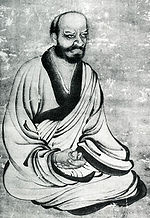The Triṃśikā-vijñaptimātratā (Sanskrit; traditional Chinese: 唯識三十論頌; pinyin: Wéishí sānshí lùn sòng; Japanese: Yuishiki sanjūronju; Korean: 유식삼십송), also...
4 KB (511 words) - 21:18, 2 April 2024
Cheng Weishi Lun (Chinese: 成唯識論; pinyin: Chéng Wéishí Lùn, CWSL, Sanskrit reconstruction: *Vijñaptimātrāsiddhiśāstra, English: The Treatise on the Demonstration...
9 KB (1,146 words) - 01:06, 30 September 2024
was known by the names of "Consciousness-Only school" (traditional Chinese: 唯識宗; ; pinyin: Wéishí-zōng; Japanese pronunciation: Yuishiki-shū; Korean: 유식종)...
48 KB (5,828 words) - 23:40, 16 September 2024
founding of Japanese Zen Buddhism. In China, the school is known as Wéishí-zōng (唯識宗, "Consciousness Only" school), or Fǎxiàng-zōng (法相宗, "Dharma Characteristics"...
3 KB (372 words) - 16:23, 6 July 2024
sutras for the Yogācāra school in his Commentary on the Cheng weishi lun (成唯識 論述記; Taishō no. 1830). Another lesser known sutra which was important in East...
150 KB (18,341 words) - 16:07, 5 October 2024
new Chinese Yogacara school, also known as the "Consciousness-Only school" (唯識宗; pinyin: Wéishí-zōng). The 6th and 7th centuries saw a flowering of new and...
73 KB (7,965 words) - 08:07, 11 October 2024
East Asian Yogācāra Buddhism (also known as "consciousness only", Ch: Weishi 唯識), which in turn influenced East Asian Buddhist thought in general. Yogācāra...
112 KB (14,511 words) - 17:46, 29 September 2024
Treatise on the Establishment of Consciousness-Only (Cheng weishi baosheng lun 成唯識寶生論; T1591, in 5 fascicles), a commentary on Vasubandhu’s Twenty Verses (Viṃśikā)...
3 KB (381 words) - 04:28, 22 January 2024
(cittamdtra)." p.96 Lusthaus states that the Cheng Weishi Lun (Chinese: 成唯識論), a commentary on Vasubandhu's Triṃśikā-vijñaptimātratā, lists three types...
13 KB (1,612 words) - 17:43, 14 September 2024
trikāya 三身 Cn: sānshēn Jp: sanjin Vi: tam thân Triṃśikā Sanskrit: Triṃśikā 唯識三十論頌 Tripitaka The "Three Baskets"; canon containing the sacred texts for Buddhism...
100 KB (940 words) - 01:29, 9 September 2024
interest in Buddhism was in the field of Yogācāra (瑜伽行派), or Consciousness-only (唯識), and he founded a school taking after that tradition in China. His 7th-century...
88 KB (11,560 words) - 01:30, 6 October 2024
essayist and philosopher whose major work A New Treatise on Vijñaptimātra (新唯識論, Xin Weishi Lun) is a Confucian critique of the Buddhist Vijñapti-mātra...
16 KB (2,215 words) - 01:45, 30 January 2024
the Nyayapravesa (因明入正理論疏, Taishō 1840 in Vol. 44) Cheng weishi lun shuji (成唯識 論述記; Taishō no. 1830, vol. 43, 229a-606c), a commentary on Xuanzang's Cheng...
6 KB (617 words) - 15:04, 26 July 2024
both existent and non-existent. In his Commentary on the Cheng weishi lun (成唯識 論述記; Taishō no. 1830), Kuiji (a student of Xuanzang), lists the following...
25 KB (2,886 words) - 03:34, 14 May 2024
also "show the influence of works of the Huayan 華嚴 (Avataṃsaka) and Weishi 唯識 (“Consciousness-only”; Yogācāra) schools." Seizan also mentions that he seems...
33 KB (4,337 words) - 12:51, 19 September 2024
Buddhism in Korea. The most popular areas of study were Wonyung, Yusik (Ch. 唯識; Weishi) or East Asian Yogācāra, Jeongto or Pure Land Buddhism, and the indigenous...
64 KB (8,075 words) - 09:01, 6 September 2024
Karel Werner, ed., The Yogi and the Mystic. Curzon Press 1989, page 94. "心識論與唯識說的發展". Archived from the original on 2009-11-30. Retrieved 2010-01-24. Nhat...
49 KB (5,511 words) - 06:13, 8 October 2024
Hwaeom (Korean: 화엄종; Hanja: 華嚴宗) and East Asian Yogācāra (Korean: 유식종; Hanja: 唯識宗) background began to travel to China to learn the newly developing tradition...
106 KB (13,063 words) - 15:02, 19 September 2024
and studied under Dōshō as one of his first pupils. Gyōki studied Yogacara (唯識), a core doctrine of Hosso, at Yakushi-ji. In 704, he returned to his birthplace...
7 KB (959 words) - 13:02, 16 January 2023
Madhyamaka), School of dharmalaksana and vijnaptimatra (faxiang weishi zong 法相唯識宗) and School of dharma-dhatu and perfect enlightenment (fajie yuanjue zong...
18 KB (2,219 words) - 01:59, 26 September 2024
jushe shilun (阿毘達磨俱舍釋論, Abhidharmakośabhāṣya, T. 1559) Dasheng weishi lun (大乘唯識論, Viṃśikā, T. 1589). She dasheng lun (攝大乘論, Mahāyānasaṃgraha, T. 1593). She...
23 KB (2,834 words) - 09:16, 11 July 2024
13 (대각국사외집; 大覺國師外集 13권) Ganjeongseongyusiknondangwa vol. 3 (간정성유식론단과; 刊定成唯識論單科 3권) Cheontaesagyouiju vol. 3 (천태사교의주; 天台四敎儀註 3권) Tiantai Buddhism Korean...
8 KB (711 words) - 07:51, 13 September 2024
Xuanzang, Chengguan often relies on and quotes Xuanzang's Cheng weishi lun (成唯識論; Demonstration of Consciousness-only; T. 1585). Chengguan also interpreted...
24 KB (3,020 words) - 14:04, 21 September 2024











